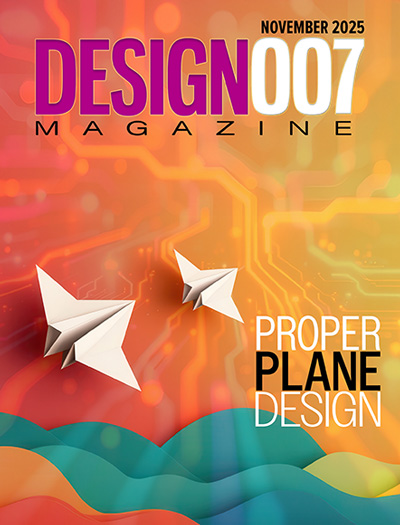-

- News
- Books
Featured Books
- design007 Magazine
Latest Issues
Current Issue
Designing Proper Work-Life Balance
In this issue, we hear from designers, marketers, and business owners on how they apply their professional skills to their personal lives to build a healthier work-life balance.

Designing Proper Planes
Without planes, designers would have to create thousands of traces to accomplish the same objectives. Power planes provide low impedance and stable power, and ground planes stabilize reference voltage, improve thermal performance, and help preclude EMI issues.

Power Integrity
Current power demands are increasing, especially with AI, 5G, and EV chips. This month, our experts share “watt’s up” with power integrity, from planning and layout through measurement and manufacturing.
- Articles
- Columns
- Links
- Media kit
||| MENU - design007 Magazine
IPC White Paper Emphasizes the Critical Importance of ‘Design for Excellence’ Throughout the Full Ecosystem of Electronics Design
June 27, 2024 | IPCEstimated reading time: 1 minute
A new white paper from IPC’s Chief Technologist (CTC) and Design Leadership (DLC) Councils, Better Electronics by Design: Next Generation Design Needs explores the elements of the “Design for Excellence” methodology, re-thinking how it needs to be further defined and applied in the full ecosystem of electronics design.
In addition, the whitepaper provides a high-level exploration of the full “silicon-to-systems” ecosystem, examines the justification and implications of an Authoritative Source of Truth (ASOT), discusses the need for synergy between building blocks of electronic systems, and takes a deep dive into the subject of design rules and “design for manufacturability.”
Key messages within the white paper include:
- Electronic systems are increasingly complex and heterogeneous.
- Facilitation of an Authoritative Source of Truth (ASOT) is mandatory to ensure consistency, efficiency, and traceability.
- The industry needs a more robust and interoperable toolset to support greater silicon-to-systems collaboration.
- Diverse electronic and mechanical CAD systems must gain interoperability by including proper model-based definitions (MBD) and collaborative software to cover both disciplines.
- A shift towards true digital collaboration and automation and an early consideration of manufacturing capabilities across the development process is essential to master increasing time-to-market and complexity challenges.
“Creating better electronics by design is a common, collective goal of the electronics industry,” said Peter Tranitz, IPC senior director, technology solutions, and leader of IPC’s design initiative “To achieve this, an ASOT should be established and protocols,
standardized. To leverage the associated benefits, a culture of real digital collaboration, transparency, and accountability needs to be established. Tools need to support bi-directional, incremental exchange of information. And, design rules need to be broken down to the relevant stages of the design workflow and checks need to be performed after every stage of the design process to drive the concept of ‘shift left.’ For effective Design for Manufacturability execution, manufacturers need to provide clear guidance on manufacturing capabilities and constraints to designers.”
Download the report: https://go.ipc.org/next-gen-design.
Testimonial
"Advertising in PCB007 Magazine has been a great way to showcase our bare board testers to the right audience. The I-Connect007 team makes the process smooth and professional. We’re proud to be featured in such a trusted publication."
Klaus Koziol - atgSuggested Items
How a Business Owner Builds Boundaries
01/06/2026 | I-Connect007 Editorial TeamComplete discipline to an exercise routine has been key to helping PCB designer and business owner Zach Peterson relieve stress. Though running a company leaves little room to completely disconnect, he protects evenings and weekends for his family. His advice: Treat your health, relationships, and personal time as essential investments, not afterthoughts.
I-Connect007 Editor's Choice: Five Most-Read Articles for 2025
01/02/2026 | Michelle Te, I-Connect007Happy New Year! As we begin 2026, I would like to pause and reflect on our most-read articles from 2025. They give us insight into what you’re focused on, and what you’re trying to understand, prepare for, and improve. Each piece earned its place through relevance, depth, and sustained reader engagement.
Don Cantow Appointed as General Manager of Altium
01/02/2026 | AltiumAltium, a global leader in electronics design systems, announced the appointment of Don Cantow as General Manager of Altium, effective January 1, 2026.
Pan-European Electronics Design Conference Returns to Prague in January
12/31/2025 | Global Electronics AssociationThe Pan-European Electronics Design Conference is jointly hosted and organized by the Electronics Design and Manufacturing Association (FED) and the Global Electronics Association – two associations representing more than 3,700 companies from the electronics industry.
Syntiant Expands NDP115 With New Ultra-Thin Packages
12/30/2025 | GlobeNewswireSyntiant Corp., the recognized leader in ultra-low-power edge AI deployment, announced two new package options for its NDP115 Neural Decision Processor™, extending the chip’s reach into devices that demand highly efficient layouts and exceptionally compact form factors across consumer, industrial and healthcare markets.


